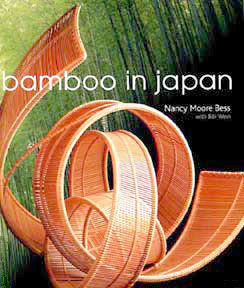
The Bright Side of Bamboo
by
Donald Richie
A Review of
BAMBOO
IN JAPAN
by
Nancy Moore Bess
with
Bibi Wein
|
| The Bright Side of Bamboo A Review of |
Bamboo, the ancient, ubiquitous grass,is everywhere in Japan. Of the over 1,500 species worldwide, nearlyhalf are found here. It is very much a part of the history andculture of the country; as Basil Hall Chamberlain noted earlyon, "So extensive is the part played by bamboo in the Japanesedomestic economy that the question is rather, what does it notdo?"
Apparently, little. Bamboo, as NancyMoore Bess discovers, has its own crafts, its own part in thetraditional arts, in the home, in the garden, in the cuisine.It has permeated the language, it plays its part in rituals, inarchitecture, in the grand assembly hall as well as in the humblekitchen.
Bess and Bibi Wein spent years poringover written sources, dictionaries, collections, whole libraries,collating everything they could find about bamboo. The resultis a compendium of information that is not likely to be soon duplicated.
It is also richly illustrated. Usingperiod designs and modern photographs, the myriad forms of bambooare displayed on every page. Most of the photographs are by TakamaShiji, but others are from local photographers such as Ken Straitonand Ben Simmons, and the author herself. Text and photos are combinedin one of the best-designed books of the year.
Also included are a glossary, notes,bibliography and a listing of sources "for observation andresearch," listing bamboo museums and craft centers in Japanand the United States, as well as local bamboo specialist stores.Heretofore, the best book on the subject was the 1970 "Bamboo"by Robert Austin and Ueda Koichiro, with photographs by Dan Levyand published by Weatherhill. Now out of print, it has found afine successor in this work.
So full is the coverage that I can thinkof only one use of bamboo that is not mentioned. This is bambooas a torture instrument -- not only the common bamboo chips underthe fingernails and bamboo poles used for piercing the hangingbody, but also an ingenious torture whereby the condemned wasstaked out over a bamboo root that was then copiously watered.The fast-growing plant thrived and its culm (or cane) piercedthe body of the unfortunate victim secured above it. The lengthof time required by this form of punishment depended upon thevariety of the bamboo.
It might be objected that the failureto include this use was because the torture was actually Chinese(or Malay, or Burmese). This is what some Japanese authoritiesmaintain. On the other hand, China has long ascribed it to Japan.In any event, this practice constitutes one of the many accreditedutilizations of bamboo in Asia.
I mention this not to be disagreeableor to spoil the reader's breakfast, but because it gives me away to further describe the volume under review. This handsomepublication is much more than a coffee-table book, but at thesame time it is not (nor does it attempt to be) a full scholarlystudy of its subject.
It is definitely reader-friendly. Theauthors "offer" this book to those who have yet to experiencethe "wonder" of bamboo; bamboo objects are "lovinglyfashioned" and possess a "warm, golden glow"; readersare (in the Californian manner) invited to "share" emotions,and people are thanked "who continually said 'yes' and witha smile."
With such a tone, one does not expecttorture. Rather, one expects an affectionate excursion into amuch-loved subject, nicely arranged and well-illustrated, andthis is what one gets.
| Price of Book | Ordering Information |